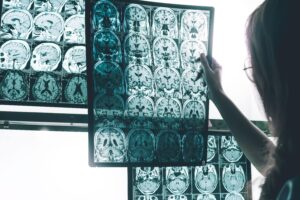Amyotrophic lateral sclerosis, or ALS, is a progressive neurological disease with a worldwide incidence of about 1.9 per 100,000 people. Diagnosing ALS can be difficult for a number of reasons; first, there is no single test to confirm the disease, leaving doctors to rely on a combination of clinical examinations and diagnostic tests. Additionally, patients may wait to seek treatment until symptoms have grown debilitating, making the disease even more difficult to treat effectively. But now, new research from the University of Michigan may have identified a crucial precursor to an ALS diagnosis: the presence of mixed metals like copper and zinc in blood and urine.
The team was led by first author Dae Gyu Jang, Ph.D., a postdoctoral fellow in the University of Michigan Health Department of Neurology, and senior author Stephen Goutman, M.D., M.S., director of the Pranger ALS Clinic. The results are published in the Journal of Neurology Neurosurgery & Psychiatry.
Could Metals Play a Role in ALS Diagnosis?
The Michigan research team has previously explored a connection between ALS and metal exposure — specifically, the ALS risk faced by production workers exposed to metals and other volatile compounds at work. Building on that research, the team recently opted to explore metal levels in a large number of patients diagnosed with ALS, regardless of patients’ previous occupational metal exposure. The team measured metal levels in plasma and urine samples from more than 450 people diagnosed with ALS. Then, they measured those same levels in nearly 300 people without an ALS diagnosis.
The team’s findings were significant. Higher levels of individual metals in urine and plasma were “significantly associated” with higher ALS risk, as well as earlier death from the disease.
Understanding the Connection Between Metals and ALS Diagnosis Risk
After establishing the connection between metal levels and ALS risk, the team created environmental ALS risk scores to determine individuals’ general risk for developing ALS. Ultimately, the environmental risk scores indicated that individuals with mixtures of metals in both plasma and urine were about three times more likely to develop ALS.
The team compared this environmental risk score to a previously determined polygenic risk score, which evaluated ALS risk posed by preexisting genetic factors. The ALS polygenic risk scores did not appear to influence the relationship between metal exposure and ALS. Interestingly, this goes against previous assumptions about how environmental factors interact with genetic variants. “While several studies suggest that environmental factors like metals interact with genetic variants to influence the onset, progression and severity of ALS, our study found that accounting for ALS polygenic risk scores did not influence the relationship between metal exposure and ALS,” said study co-author Kelly Bakulski, Ph.D.
_____
Next, scientists need to determine the precise mechanism behind metal exposure and ALS risk — in other words, how metals increase individuals’ risk of developing the disease. “Strengthening our understanding of the importance of exposure to metals as a risk factor for ALS is essential for future targeted prevention of the disease and improved therapeutic strategies,” said senior author Stephen Goutman. Moving forward, the team also hopes to use metal levels as an early diagnostic tool for ALS. Ideally, evaluating metal mixtures would help identify who is at the greatest risk of developing and dying from this devastating disease.
At Scantox Neuro, several preclinical models of ALS are available that allow researchers to evaluate the effect of metals on ALS pathology in vitro and in vivo. The sodium arsenite-induced in vitro model allows for the analysis of stress granule formation, while L-glutamate-induced lesioning in neuronal cells allows for the analysis of excitotoxicity. Available in vivo models include different SOD1-G93A and TDP-43 transgenic mice as well as AAV-TDP-43-induced mice. Behavioral tests in rodents enable the analysis of the ALS phenotype. Scantox has established further molecular and histological evaluations of the ALS pathology for ex vivo tissue analysis, and tissue of transgenic ALS animal models is readily available in our Biobank.
Scantox is the leading Nordic preclinical GLP-accredited contract research organization (CRO), delivering the highest grade of pharmacology and regulatory toxicology services since 1977. Scantox focuses on preclinical contract research services, supporting pharmaceutical and biotechnology companies with their drug development projects. Core competencies include explorative and efficacy studies, PK studies, general toxicology studies, local tolerance studies, wound healing studies, and vaccines. For more information about Scantox, visit https://scantox.com.











